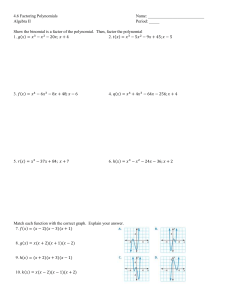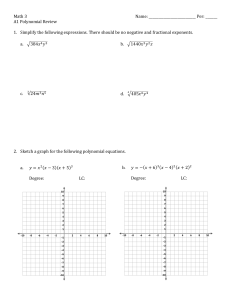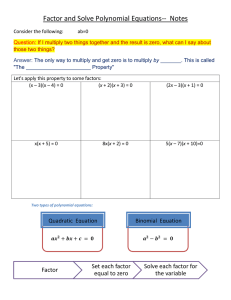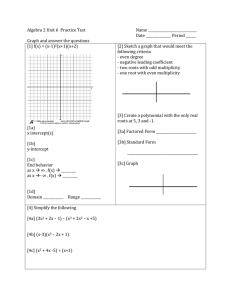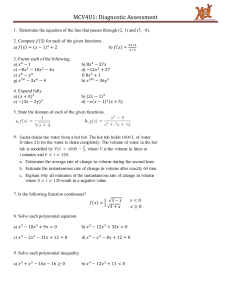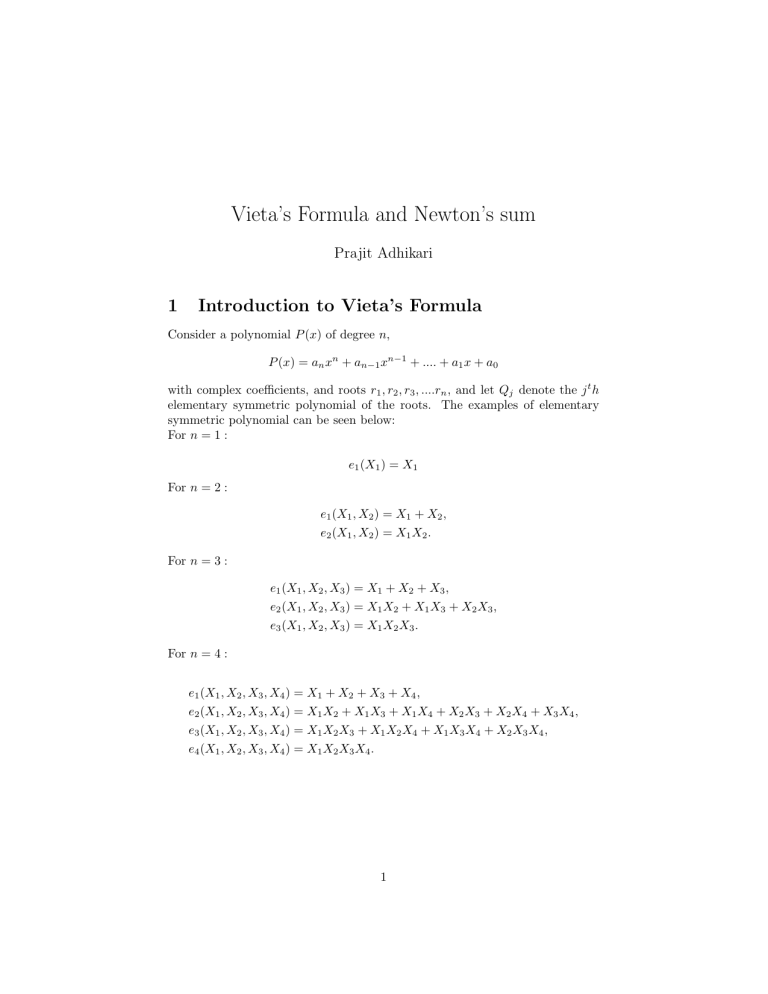
Vieta’s Formula and Newton’s sum Prajit Adhikari 1 Introduction to Vieta’s Formula Consider a polynomial P (x) of degree n, P (x) = an xn + an−1 xn−1 + .... + a1 x + a0 with complex coefficients, and roots r1 , r2 , r3 , ....rn , and let Qj denote the j t h elementary symmetric polynomial of the roots. The examples of elementary symmetric polynomial can be seen below: For n = 1 : e1 (X1 ) = X1 For n = 2 : e1 (X1 , X2 ) = X1 + X2 , e2 (X1 , X2 ) = X1 X2 . For n = 3 : e1 (X1 , X2 , X3 ) = X1 + X2 + X3 , e2 (X1 , X2 , X3 ) = X1 X2 + X1 X3 + X2 X3 , e3 (X1 , X2 , X3 ) = X1 X2 X3 . For n = 4 : e1 (X1 , X2 , X3 , X4 ) = X1 + X2 + X3 + X4 , e2 (X1 , X2 , X3 , X4 ) = X1 X2 + X1 X3 + X1 X4 + X2 X3 + X2 X4 + X3 X4 , e3 (X1 , X2 , X3 , X4 ) = X1 X2 X3 + X1 X2 X4 + X1 X3 X4 + X2 X3 X4 , e4 (X1 , X2 , X3 , X4 ) = X1 X2 X3 X4 . 1 So, from Vieta’s formula, we have, an−1 an an−2 Q2 = r1 r2 + r1 r3 + · · · + rn−1 rn = an .. . a0 Qn = r1 r2 r3 · · · rn = (−1)n . an Q1 = r1 + r2 + · · · + rn = − For n=3, we have, The roots r1 , r2 , r3 of the cubic polynomial P (x) = ax3 + bx2 + cx + d satisfy b r1 + r2 + r3 = − , a 2 r1 r2 + r1 r3 + r2 r3 = c , a d r1 r2 r3 = − . a Problems 1. Find a quadratic whose roots are 5 and 8. 2. Find all polynomials P (x) = xn + an−1 xn−1 + · · · + a0 such that ai = ±1 for all 0 ≤ i ≤ n − 1 satisfying the condition that all roots of P (x) are real. 3. Let x1 , x2 , ..., x10 be the roots of the polynomial x10 + x9 + · · · + x + 1. Find the value of 10 X 1 . 1 − xn n=1 4. The polynomial x3 −ax2 +bx−2010 has three positive integer roots. What is the smallest possible value of a? (A) 78 (B) 88 (C) 98 (D) 108 (E) 118 5. Let r, s, and t be the three roots of the equation 8x3 + 1001x + 2008 = 0. Find (r + s)3 + (s + t)3 + (t + r)3 . 6. For certain real numbers a, b, and c, the polynomial g(x) = x3 + ax2 + x + 10 has three distinct roots, and each root of g(x) is also a root of the polynomial f (x) = x4 + x3 + bx2 + 100x + c. What is f (1)? 2 3 Newton’s sum Newton’s identities, also known as Newton-Girard formulae, is an efficient way to find the power sum of roots of polynomials without actually finding the roots. If x1 , x2 , . . . , xn are the roots of a polynomial equation, then Newton’s identities are used to find the summations like n X xki = xk1 + xk2 + · · · + xkn . i=1 It can be derived from the Vieta’s formula playing with the elementary symmetric polynomial. Consider a polynomial P (x) of degree n, P (x) = an xn +an−1 xn−1 +· · ·+a1 x+a0 Let P (x) = 0 have roots x1 , x2 , . . . , xn . Define the sum: Pk = xk1 + xk2 + · · · + xkn . Newton’s sums tell us that, an P1 + an−1 = 0 an P2 + an−1 P1 + 2an−2 = 0 an P3 + an−1 P2 + an−2 P1 + 3an−3 = 0 .. . (Define aj = 0 for j < 0.) We also can write: P1 = S1 P2 = S1 P1 − 2S2 P3 = S1 P2 − S2 P1 + 3S3 P4 = S1 P3 − S2 P2 + S3 P1 − 4S4 P5 = S1 P4 − S2 P3 + S3 P2 − S4 P1 + 5S5 .. . where Sn denotes the n-th elementary symmetric sum. 3 4 Problems: 1. consider the polynomial P (x) = x3 + 3x2 + 4x − 8. Let the roots of P (x) be r, s and t. Find r2 + s2 + t2 and r4 + s4 + t4 . 2. Consider the polynomials P (x) = x6 − x5 − x3 − x2 − x and Q(x) = x4 − x3 − x2 − 1. Given that z1 , z2 , z3 , and z4 are the roots of Q(x) = 0, find P (z1 ) + P (z2 ) + P (z3 ) + P (z4 ). 3. Let sk denote the sum of the kth powers of the roots of the polynomial x3 − 5x2 + 8x − 13. In particular, s0 = 3, s1 = 5, and s2 = 9. Let a, b, and c be real numbers such that sk+1 = a sk + b sk−1 + c sk−2 for k = 2, 3, .... What is a + b + c? 4. Given the following system of equations: x+y+z =1 2 x + y2 + z2 = 2 x3 + y 3 + z 3 = 3, find the smallest positive integer value of n (¿ 3)n (¿3) such that xn + y n + z n is an integer. 4 References: 1. Brilliant 2. Art of Problem Solving 3. Wikipedia 5

